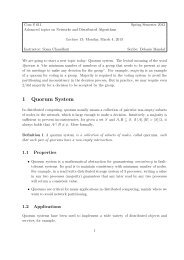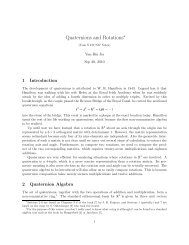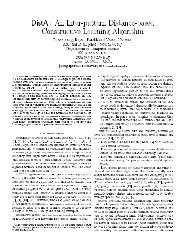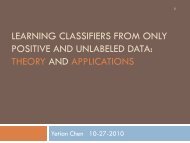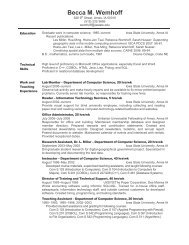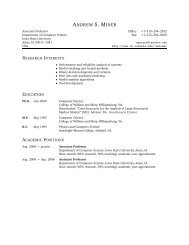Dr. Vasant Honavar Department of Computer Science honavar@cs ...
Dr. Vasant Honavar Department of Computer Science honavar@cs ...
Dr. Vasant Honavar Department of Computer Science honavar@cs ...
You also want an ePaper? Increase the reach of your titles
YUMPU automatically turns print PDFs into web optimized ePapers that Google loves.
social phenomena – just as calculus provided Newton and his successors with a language for modeling physical<br />
phenomena.<br />
I was drawn to <strong>Computer</strong> <strong>Science</strong> because <strong>of</strong> the possibility <strong>of</strong> understanding biological, cognitive, and social phenomena<br />
in terms <strong>of</strong> processes that acquire, store, retrieve, manipulate, and use information. I am passionate about introducing<br />
students to algorithmic approaches to exploring fundamental questions in biological, cognitive, and social sciences and to<br />
the challenges <strong>of</strong> developing information processing artifacts and s<strong>of</strong>tware that can dramatically improve our quality <strong>of</strong><br />
life.<br />
Teaching Style<br />
My personal teaching style involves:<br />
(a) Teaching what I enjoy learning – this ensures that the students sense my interest and excitement in the topic.<br />
(b) Engaging students so that they become active participants in the learning process rather than passive observers<br />
(“What I hear, I forget. What I see, I remember. What I do, I understand” – Confucius).<br />
(c) Setting the stage for the topic <strong>of</strong> study – We learn what we almost already know. Hence I find it useful to develop<br />
complex idea or a pro<strong>of</strong> through a succession <strong>of</strong> smaller steps.<br />
(d) Setting clear and realistic goals – Students respond best, and learn most, from learning goals that are both<br />
challenging and achievable. Assignments that are trivial are boring. Assignments that are excessively difficult can be<br />
frustrating and intimidating.<br />
(e) Letting students make mistakes and learn from them. Exploration and experimentation are essential to learning and<br />
discovery and learning what does not work (and why) is as important as learning what works (and why).<br />
(f) Accomodating different learning styles – Kolb identifies several learning styles. Some learn best from observations<br />
and examples; others by acquiring general principles and knowledge <strong>of</strong> how to apply them in specific situations;<br />
others by deducing and discovering general principles or theories; and yet others by doing – that is, by trying things,<br />
making mistakes, and learning from them. I find it useful to develop course materials that exercise multiple learning<br />
styles.<br />
Teaching and Curriculum Development Experience<br />
Over the past fourteen years, I have designed, developed, and taught undergraduate as well as graduate courses and<br />
seminars in artificial intelligence, intelligent agents and multi-agent systems, machine learning, data mining and<br />
knowledge discovery, neural and evolutionary computation, computational learning theory, bioinformatics and<br />
computational molecular biology. The material covered in the courses is chosen with an emphasis on concepts that are<br />
likely to have a lasting impact on the discipline in the years to come. In addition to introducing students to a core body <strong>of</strong><br />
knowledge in the areas <strong>of</strong> study, these courses present such knowledge in the broader context <strong>of</strong> computer science as an<br />
intellectual discipline and to develop the students into creative thinkers and problem-solvers, be it in academic research or<br />
advanced technology development.<br />
The undergraduate and graduate courses that I have developed and taught over the years introduce students to some <strong>of</strong><br />
the most challenging topics in computer science - involving the application <strong>of</strong> concepts and tools from the theory <strong>of</strong><br />
computation, design and analysis <strong>of</strong> algorithms, and design <strong>of</strong> s<strong>of</strong>tware systems in the construction <strong>of</strong> intelligent artifacts:<br />
computer programs that represent and reason with and about knowledge, acquire knowledge from interaction with their<br />
environment, and discover and use regularities from data.<br />
I developed (in 1991) and taught a combined upper level undergraduate and introductory graduate course in Artificial<br />
Intelligence with emphasis on fundamental problems and approaches in the design <strong>of</strong> intelligent agents at a time when no<br />
suitable textbook was available. Because no suitable textbook was available at the time, I developed all <strong>of</strong> the necessary<br />
course material in the form <strong>of</strong> lecture notes. Some <strong>of</strong> these notes were adapted for use in similar courses at other<br />
universities. In 1995, when Russell and Norvig’s textbook became available, I adopted it for use in this course with my<br />
Dec 2005<br />
34



